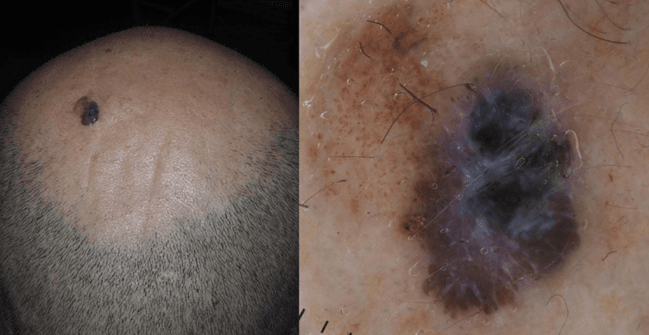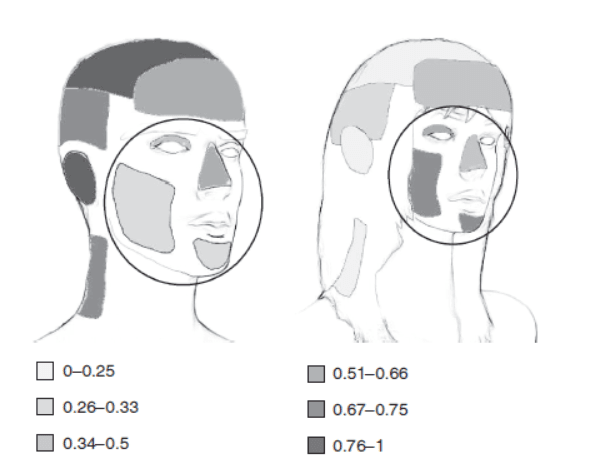
- Knowledge
- Agacell
- Dermatology
- Alopecia
Melanoma and androgenetic alopecia

José Ángel Sánchez García, PhD
Alopecia not only affects physical appearance but can also increase the risk of serious health problems such as melanoma. Melanoma is a cancer that develops in melanocytes specialized skin cells that determine hair and skin colour through the production of the pigment called melanin. Lack of hair in people with alopecia directly exposes the scalp to harmful ultraviolet (UV) rays, increasing the risk of developing melanoma in this area.
Melanoma of scalp and neck: constitutes approximately 3–5% of all cutaneous melanomas (1).
Mortality and diagnosis: melanomas on the scalp and neck have a lower survival rate compared to other areas of the body, as they are often diagnosed at later stages. Through a retrospective study melanomas on the scalp are known to show a higher risk to metastasize towards brain and hence a worse prognosis. This fact has been explained because of a poorer area visibility, which lead to a delayed diagnosis, and to scalp histology, defined by a rich lymphatic and blood vessels niche, and folliculotropism (2) These bald melanomas were also known to be thicker than those developed on hairy scalp and normally related to older subjects. In some occasions this thickness is associated to a delayed diagnosis because of sometimes they are less prone to attend a physician (3).
Risk factors: scalp melanomas, also known as invisible killers, are more common in the elderly than in young population due to an accumulate harmful effect of UV radiation. In addition, its prevalence is six times higher in men than in women. This relevant gender difference is also blamed for androgenetic alopecia incidence. (4) Individuals with fair skin, presents also a higher risk of developing melanoma.

Nevus associated melanoma on the scalp of a 45-year old man. On the right in dermoscopy melanoma component is observed with blue-white veil, shiny-white streaks.(Licata et al., 2021).
Gender-related differences
In order to assess different melanoma locations, Lesage et al . 2013 (5) divided them in two regions: central, which included cheeks, nose and chin, and peripheral, referring to the resting head surface and neck. A mild higher prevalence of head and neck melanomas in the peripheral area was reported in men (56,7%) and a 79,3% in central area in women. Assessing these data, peripheral and central regions melanoma development were relatively equitable in men in contrast to women whose lower androgenetic alopecia prevalence protects against peripheral melanoma. In fact, peripheral melanoma types showed a higher proportion of invasive tumours as well as nodular and superficial spreading and a lower development of lentigo maligna melanoma, a non-invasive and slow growing type. These results highlighted the importance of hair coverage not only for melanoma avoidance but also for its invasive and metastasizing properties.
Furthermore, hairy scalp melanomas were more common in women hence it is assumed that a genetic background in these cases is more patent. In bald cases UV radiation seems to play a responsible leading role (2).

Differential anatomic distribution of head and neck melanomas (HNMs) according to genderFor each area, the proportion of cases among the total number has been calculated and translated into corresponding levels of gray. Central area is the one is limited by the circle. Peripheral area includes the rest of the surface. (6).
Preventive measures
Self-examination of the scalp has obvious limitations. Careful inspection of the subject scalp at in consultation areas by doctors is not always carried out, thus being a lacking procedure (1)
Routine scalp examination should be encouraged aiming at early detection not only of melanomas but also of non-melanoma skin cancers (2). It is advisable to encourage patients to engage their hairdresser for this task. In numerous studies their role has been critical for a prompt diagnosis(1). Other measures including bald surface coverage using hats and caps and UV photoprotection are crucial for avoiding UV damage. Lesage et al. (2013) (5) also highlighted sun creams application while travelling by car. General thought claims car glasses totally protect against UV radiation however they do not. Professional drivers are especially encouraged to keep windows closed and to use air conditioning and even in the first case to use hats and neck protection (5).
Conclusion
In summary, association between androgenetic alopecia and melanoma highlights several critical elements that increase likelihood of developing this aggressive form of skin cancer. Androgenetic alopecia results in an increased UV exposure due to hairless scalp leading to melanoma susceptibility increase. In particular, the knowledge of gender differences and other hormonal influences may also contribute to a more accurate prognosis. Therefore, subjects with androgenetic alopecia , especially men, should closely monitor their scalp for signs of melanoma.
References
Xie C, Pan Y, McLean C, Mar V, Wolfe R, Kelly JW. Scalp melanoma: Distinctive high risk clinical and histological features. Australasian Journal of Dermatology. 2017 Aug 1;58(3):181–8.
Pereira AR, Collgros H, Guitera P, Benati E, Longo C, Argenziano G, et al. Melanomas of the scalp: is hair coverage preventing early diagnosis? Int J Dermatol. 2021 Mar 1;60(3):340–6.
Benati E, Longo C, Bombonato C, Moscarella E, Alfano R, Argenziano G. Baldness and scalp melanoma. Journal of the European Academy of Dermatology and Venereology [Internet]. 2017 Dec [cited 2019 Jul 22];31(12):e528–30. Available from: http://www.ncbi.nlm.nih.gov/pubmed/28602049
Licata G, Scharf C, Ronchi A, Pellerone S, Argenziano G, Verolino P, et al. Diagnosis and management of melanoma of the scalp: A review of the literature. Vol. 14, Clinical, Cosmetic and Investigational Dermatology. Dove Medical Press Ltd; 2021. p. 1435–47.
Lesage C, Barbe C, Le Clainche A, Lesage FX, Bernard P, Grange F. Sex-related location of head and neck melanoma strongly argues for a major role of sun exposure in cars and photoprotection by hair. Journal of Investigative Dermatology. 2013;133(5):1205–11.